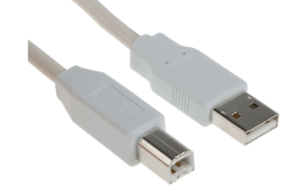Introduction
Universal Serial Bus
As personal computers began to grow in popularity, so did the number of peripheral devices that could be connected to a computer. Thousands of devices, such as printers, joysticks, mice, keyboards, scanners, etc needed a way of connecting to the pc. Unfortunately this meant that PCs had to support a wide number of devices, each with different methods of connecting to the machine.
This created a huge problem:
- Consumers had to buy the devices that matched the particular port.
- Manufacturers had to choose which ports to support
- PCs and Laptops had to had lots of ports, few of which were actually used.
- As older technology was replaced their was a huge amount of electrical waste
- Devices needed to be configured manually each time you connected them.
What was needed was a single standard port that would accept any device and eventually the USB standard was agreed.
USB
Universal Serial Bus

The original USB cable
The USB standard established a set of rules by which a wide range of devices could be connected to any free USB port.
This had a huge number of advantages:
- All ports had the same connection, meaning less waste and fewer cable problems.
- Newer versions of USB are backwards compatible with older hardware.
- THE USB standard also included ‘Plug and Play’, meaning that if you plugged in a device then more often than not it would be recognized by the computer and configured for use straight away.
- Less environmental waste from old cables.
- Each machine required fewer ports.
- Because the connection is serial rather than parallel data transfer is more reliable.
As computers became faster and data transfer requirements increased the original USB 1.0 standard (1.5Mbps) became too slow and so never versions (2.0, 3.0, 3.1) have been developed and now USB can transfer data up to 10Gbps, over 1000 times faster than the original specification.
In Europe USB has become such a dominating standard that the EU is even trying to force apple to use USB-C in all their devices.
Resources
Past Paper Questions
0478/11 – Paper 1 Theory May/June 2015 Qn 2
0478/11 Paper 1 Theory May/June 2016 Qn 4a
0478/12 – Paper 1 Theory May/June 2017 Qn7c
